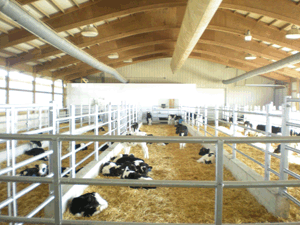There has been a lot of discussion about group calf housing recently. Perhaps you are giving it serious consideration on your operation. Before diving in there are a few questions you may want to ask yourself, advises Ed Denton, calf and heifer specialist with Purina Animal Nutrition LLC. Questions that merit discussion include: Do I want to utilize mechanical feeding (auto-feeder) or ad-lib feeding (barrel feeder)? What square footage will my current calf rearing facilities allow? How do I wean the calves?

To begin answering these questions, Denton recommends to first look at the differences between the feeding systems and housing.
Automated feeders
Auto-feeders are available in several brands; most dairies look to the same brand as their current milking equipment. Radio frequency identification or RFID equipment typically interfaces with both the auto-feeder and milking equipment. This auto-feeding equipment enables the collection of almost endless data on individual calves. Producers with automated feeders commonly review daily intake, drinking speed and frequency of meals. This data enables calf managers an opportunity for early diagnosis of calf illness. Slow drinking speed can be an excellent indicator of oncoming calf illness.
These feeding units require large capital investments and typically feed two or four groups of calves. Because of the large investment, the groups tend to be large and number between 20 to 25 calves per group. Larger groups increase equipment efficiencies, but increase housing challenges. Auto-feeders can dispense milk replacer and/or pasteurized waste milk.
Barrel feeders
Barrel feeders are typically "homemade," utilizing tools readily available. "Because of the simplistic approach there is no electronic identification and data collection for each calf all intake measurement is truly reviewed as a group," notes Denton. The capital investment in the equipment is low and therefore encourages the use of more units with smaller groups.
Research indicates fewer respiratory issues are typically seen in groups of 6 to 8 calves vs. larger groups. "Smaller groups also enable a level of pseudo-individual care," says Denton. Barrel feeder systems can also dispense milk replacer and/or pasteurized waste milk and typically are used with acidified milk or milk replacer.
Acidified milk/milk replacer allows for supplying milk/milk replacer to calves less often. Purina Animal Nutrition has an Acidified Milk replacer that utilizes a blend of food grade organic acids to lower the pH of the milk replacer to permit mixing every 1 to 2 days. "When feeding acidified milk/milk replacer, it is imperative to agitate the milk for short periods of time every hour to prevent separation of milk protein and fat from the whey," notes Denton.
Housing
The common challenging piece of grouped housing systems is respiratory disease. The question producers ask is, how to reduce and/or prevent it? Because the feeding equipment enables multiple meals and provides increased nutrition to the calf, the resulting calf is larger. This, after all, was the original goal. But this higher level of nutrition results in higher volumes of fecal waste and urine, thus higher moisture and ammonia levels in groups. Also larger calves produce higher levels of moisture in the air via respiration.
In order to help improve the pen environment, drainage of the bedding pack is vital, notes Denton. This may involve multiple cleanings and rebuilding of the pack prior to a group being weaned and moving out of the pen. The recommendation is 30 to 40 square feet per calf on the pack. This does not include the area where calves feed. Since the goal is larger calves, it is best to provide for the higher square footage so when calves approach weaning age you have adequate pen space.
The capstone of the entire system is the ventilation system in the group facilities. The use of positive air tubes enables the best year round ventilation. This system brings in outside air and distributes the clean fresh air at a speed that does not create a draft or cold stress on the calves.
Another challenge is viral disease transmission via a common nipple. Be mindful, a calf's mouth and muzzle is the equivalent of a human's hands. Calves touch and lick everything in their environment. Calves frequently lick their own nose. A calf that has just licked its own nose goes to the common nipple and feeds thus contaminating the nipple for the next calf. "We humans are constantly reminded to wash our hands to prevent the spread of disease. We cannot wash a calf's muzzle, but we can wash the item they use frequently the milk nipple," advises Denton.
Weaning
Now, let's look at weaning calves in the two systems. "Keep in mind that a minimum of two pounds of starter daily, per calf, for three consecutive days is the trigger to wean a calf," reminds Denton.
Auto-feeders allow for greater ease to wean calves. The ability to program the availability of milk for calves on an individual basis allows for the "dialing down" of milk over a series of days to promote starter intake. Conversely, an ad-libitum system does just as it is called - feeding ad-libitum. Because the system feeds "the group" one must plan to wean "the group" based on the age of the youngest calf in the pen.
"Prior to moving towards group housing, it's important to take aspects of each system into consideration," says Denton. "Think through your needs not only today, but also what they might be in the future too."
For more information contact your Purina Animal Nutrition representative or go to: www.amplicalf.com.
Purina Animal Nutrition LLC (www.purinamills.com) is a national organization serving producers, animal owners and their families through more than 4,700 local cooperatives, independent dealers and other large retailers across the United States. Driven by an uncompromising commitment to animal excellence, Purina Animal Nutrition is an industry innovator, offering America's leading brands of complete feeds, supplements, premixes, ingredients and specialty technologies for the livestock and lifestyle animal markets. Headquartered in Shoreview, Minn., Purina Animal Nutrition LLC is a wholly owned subsidiary of Land O'Lakes, Inc.
12.18.2012